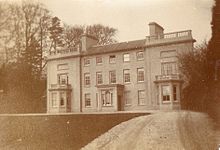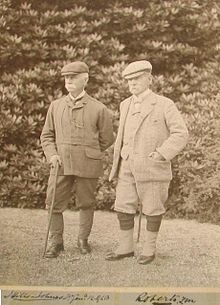- Dolaucothi Estate
-
The Dolaucothi Estate, or as it was often later spelt, Dolaucothy Estate is situated about one mile north-west of the village of Caio in the upper reaches of the picturesque Cothi valley in the parish of Cynwyl Gaeo, Carmarthenshire. The name Dolaucothi means ‘the meadows of the Cothi’ and the now demolished mansion house of the Johnes family stood close by to the banks of the fast flowing River Cothi. In 1873 the estate comprised 3172 acres.[1]
The approach to the house was by two drives of considerable length, that in the east skirting the Dolaucothi Roman Gold Mines (Ogofau, near Pumsaint), while that in the west was flanked by four lines of ancient oaks — the "very noble oaks" that George Borrow (1803–1881) remarked upon when he walked along the avenue in 1854 to glimpse the house, charmed by the thought that "he had never seen a more pleasing locality".[2]
Contents
Johnes family
The Dolaucothi Estate was acquired in the late 16th century by the Johnes family upon the marriage of James Johnes (1552 - ?) to Anne Lewis (née Thomas) (1565 - ?), widow of James Lewis and heiress of John Thomas of Cryngae and Dolaucothi. James Johnes was the youngest son of Sir Thomas Johnes (1530-?), of Abermarlais, Carmarthenshire and Haroldston, Pembrokeshire, and Mary, widow of Sir Thomas Perrott of Haroldston, and daughter and heir of the Hon. Sir James Berkeley, second son of Maurice, 8th Lord Berkeley. Sir Thomas Johnes became First Knight of the Shire for that County, and Sheriff of Carmarthenshire in 1541 and Cardiganshire in 1544.[3]
John Johnes (1768–1816), a former army officer, purchased the estate in 1800 from his cousin and brother-in-law Colonel Thomas Johnes M.P. (1748–1816) of the great Hafod Estate and Lord Lieutenant of Cardiganshire.[4]
Architecture
The house had an early 18th century five bay, three storey front with older parts to the rear.[5] The house was in the form of a cube containing 28 rooms. In 1679 it contained 6 hearths and was described as ‘simple and dignified’.[6] John Nash (1752–1835) was employed in 1792 to add the porch and two low wings, each with a window in a recessed arch. At that time, Nash had just finished working on the famous octagonal domed library and square pavilions at Hafod for Thomas Johnes.[7]
John Johnes son, also John, who become Judge Johnes (1800–1876) had the low wings raised and added bay windows in 1871. Dolaucothi Mansion with the 1871 additions recently completed is shown to the right. In its heyday Dolaucothi carried an indoor staff of nine and an outside staff of eighteen.[8] Dolaucothy has been described as having interiors of much charm, important portraits and Eastern war trophies of General Hills V.C.[9]
Murder of Judge John Johnes
Judge Johnes was educated at Oxford and in due course called to the Bar. He was a good businessman and soon had put the whole estate on a sound financial basis. In 1822 he married Elizabeth Edwardes, daughter and heiress of the Reverent John Edwardes (1765–1847) of Gileston Manor in Glamorganshire, a younger branch of the family of Edwardes, of Rhyd-y-gors. They had two daughters, Charlotte Anne Maria (1825–1911) and Elizabeth (1834–1927). Judge Johnes became a widower when his wife Elizabeth died on the 25 June 1848.[10]
Charlotte married Captain Charles Caesar Cookman Esq, the eldest son of Edward Rogers Cookman, Esq. of Monart House, County of Wexford. Charles Cookman died on 4 June 1859 leaving Charlotte a widow.
In the summer of 1876, Dolaucothi made national news when Judge John Johnes was infamously murdered in his study on 19 August by Henry Tremble, his Irish butler of 17 years service, who killed him with his masters’ shotgun. Tremble also severely wounded Charlotte Cookman, whose life was saved by one of the other servants. Tremble was very upset that Judge Johnes had refused his application for the tenancy of the Dolaucothi Arms, a local public house, which he had previously promised to him. Johnes' reasons for not considering Henry Tremble for the position involved Trembles’ wife's disposition for drinking excessively.[11]
Tremble then headed into the village of Caio with the intention of murdering John Davies, the inn keeper he felt had deprived him of the position he sought. Fortunately John Davies was away in Carmarthen that day, so after threatening a local police constable he retired to his own house ‘Myrtle Cottage’ and shot himself.
Henry Tremble, 36, entered service at Dolaucothi upon the death of Captain Cookman in 1859. Tremble had been Captain Cookman’s valet in Ireland and he had accompanied him to Wales upon his marriage to Charlotte. At Dolaucothi he worked his way up to the role of butler but was known to possess a somewhat violent disposition. John Johnes would have dismissed him on several occasions previously, but was dissuaded from doing so by Charlotte, who felt that this would betray the memory of her late husband who had commended the care of his favourite servant to her.[12]
On the 26 August 1876 Judge Johnes' remains were interred in the family vault at Caio Church, when the Revs. Canon Phillips, subsequently Dean of St. David's, and Charles Chidlow, Vicar, officiated.[13] Charlotte resumed the name of Johnes under her father's will of 1876 and lived out her days at Dolaucothi, co-inherited with her sister Elizabeth.[14]
Sir James Hills-Johnes
In 1882 her younger sister Elizabeth went on to marry Lieutenant General Sir James Hills (1833–1919), a Victoria Cross hero of the Indian Mutiny and former military Governor of Kabul. Sir James assumed, by royal licence, the additional name and arms of Johnes to become Lieutenant General Sir James Hills-Johnes V.C. GCB. He then took over the running of the Dolaucothi Estate [15] and played a valued part in Welsh life, becoming honorary colonel of the 4th battalion of the Welch Regiment, was J.P. and Deputy Lieutenant for Carmarthenshire, served as high sheriff of that county in 1886, and was made an honorary freeman of the town of Carmarthen in 1910. He was treasurer of University College Wales, 1898–1919, and was awarded the honorary degree of LL.D. by the University College Wales in 1917.[16]
His wife Elizabeth had in her early days been a ward of Lady Llanover and had moved in fashionable and literary circles, her life on one occasion being saved by the great Lord Lytton. Her correspondence with the famous Bishop of St Davids, Connop Thirlwall, was published in 1881under the title ‘Letters to a Friend’. The house was always full of guests, among them many distinguished men and women like Lord Roberts (1832–1914) and Sir Henry Morton Stanley (1841–1904), the African explorer.[17]
Lord Roberts and Sir James began a life-long friendship when they were cadets at Addiscombe Military Academy. Lord Roberts joined the Bengal Artillery in 1851, and Sir James, who is just 11 months Lord Roberts' junior, joined the same corps in 1853. Both experienced the dangers and perils of the Indian Mutiny, were present at the siege of Delhi and took part in the operations at the relief of Lucknow. Both were dangerously wounded at the siege of Delhi and before the Mutiny ended, both received the Victoria Cross. A decade later they served together again in the Abyssinian and Kabul campaigns and in 1881 the pair received the thanks of both Houses of Parliament.[18]
Charlotte Johnes died in 1911, Sir James in 1919 and his wife Elizabeth at the great age of 95 in 1927. Upon their deaths the Dolaucothi estate passed through a female line to the Lloyds who added Johnes to their name. The house was requisitioned by the Ministry of Supply during World War II and during this time fell into serious disrepair including the floors collapsing and the lead taken from the roof. Dolaucothi was presented to the National Trust in 1941 subject to the life interest of the owner, Mr Lloyd-Johnes, on whose death in 1956, it became the absolute property of the trust. The mansion was demolished in 1952.[19] All that remains of the mansion house is one service wing that now serves as an estate farmhouse.[20]
St Cynwyl church
The church of St Cynwyl is located in the centre of Caio, surrounded by lands originally part of the substantial Dolaucothi Estate. This was the place of worship of the Johnes family and against the northern wall lies the Dolaucothi family vault from 1815. There is also a memorial plaque commemorating Lieutenant General Sir James Hills-Johnes VC, GCB (20 August 1833 - 3 January 1919) within the lychgate leading into the churchyard.[21]
Ogofau gold mine
The ancient Roman gold mines at Dolaucothi, also known as the Ogofau Gold Mine were part of the large estate. Attempts to extract further gold from the mines were undertaken in 1797 for John Johnes and again in the 1850s and in 1871 for his son Judge John Johnes when crushing machinery was introduced. Larger efforts to extract gold from the mine were undertaken between 1888 and1892 by the South Wales Gold Mining Co, in 1905–1910 and more notably in 1933 – 38, when Britain’s abandonment of the gold standard led to a much greater interest in native gold.[22] Those later attempts were unsuccessful in extracting commercial quantities of gold, although interest in the deposits remains.
References
- ^ Historic Carmarthenshire Homes and their Families, (Francis Jones, 2006, Brawdy Books, Pembrokeshire)
- ^ A House That Borrow Admired (H.J. Lloyd Johnes) Available at
- ^ Burke's Landed Gentry (London, 18th ed, 3 vols, 1965-72), vol. 1.
- ^ The buildings of Wales – Carmarthen and Ceredigion – Thomas Lloyd, Julian Orbach and Robert Scourfield, Yale University press, 2006
- ^ The Lost houses of Wales, (Thomas Lloyd, 1987, Save Britains Heritage, London)
- ^ Historic Carmarthenshire Homes and their Families (Francis Jones, 2006, Brawdy Books, Pembrokeshire)
- ^ The Lost houses of Wales, (Thomas Lloyd, 1987, Save Britains Heritage, London)
- ^ A House That Borrow Admired (H.J. Lloyd Johnes) Available at
- ^ The Lost houses of Wales, (Thomas Lloyd, 1987, Save Britains Heritage, London)
- ^ Historic Carmarthenshire Homes and their Families (Francis Jones, 2006, Brawdy Books, Pembrokeshire)
- ^ A Devil Who Cared for His Own - The Dolaucothi Murder Viewed Anew (Susan Beckley, B.A., D.A.A.) Available at; [1]
- ^ A Devil Who Cared for His Own - The Dolaucothi Murder Viewed Anew (Susan Beckley, B.A., D.A.A.) Available at; [2]
- ^ History of Caio, Carmarthenshire (Fred S. Price, 1904), B Trerise, Prince of Wales Road
- ^ A House That Borrow Admired (H.J. Lloyd Johnes) Available at
- ^ A House That Borrow Admired (H.J. Lloyd Johnes) Available at
- ^ National Library of Wales – Welsh Biography Online Available at
- ^ A House That Borrow Admired (H.J. Lloyd Johnes) Available at
- ^ History of Caio, Carmarthenshire (Fred S. Price, 1904), B Trerise, Prince of Wales Road
- ^ Historic Carmarthenshire Homes and their Families (Francis Jones, 2006, Brawdy Books, Pembrokeshire)
- ^ The buildings of Wales – Carmarthen and Ceredigion – Thomas Lloyd, Julian Orbach and Robert Scourfield, Yale University press, 2006
- ^ The buildings of Wales – Carmarthen and Ceredigion – Thomas Lloyd, Julian Orbach and Robert Scourfield, Yale University press, 2006
- ^ The buildings of Wales – Carmarthen and Ceredigion – Thomas Lloyd, Julian Orbach and Robert Scourfield, Yale University press, 2006
External links
- [3] Carmarthen County War Memorial
- Location of grave and VC medal Dyfed, Wales
- Lt Gen. Sir James Hills-Johnes at Find a Grave
Categories:- Carmarthenshire
- History of Carmarthenshire
- Archaeological sites in Carmarthenshire
- Buildings and structures in Carmarthenshire
- Britain's lost houses
Wikimedia Foundation. 2010.




